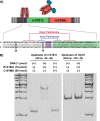Mycobacterium tuberculosis Rv3160c is a TetR-like transcriptional repressor that regulates expression of the putative oxygenase Rv3161c
- PMID: 33452380
- PMCID: PMC7810876
- DOI: 10.1038/s41598-021-81104-y
Mycobacterium tuberculosis Rv3160c is a TetR-like transcriptional repressor that regulates expression of the putative oxygenase Rv3161c
Abstract
Tuberculosis, caused by Mycobacterium tuberculosis (Mtb), is a major health threat listed among the top 10 causes of death worldwide. Treatment of multidrug-resistant Mtb requires use of additional second-line drugs that prolong the treatment process and result in higher death rates. Our team previously identified a 2-pyridone molecule (C10) that blocks tolerance to the first-line drug isoniazid at C10 concentrations that do not inhibit bacterial growth. Here, we discovered that the genes rv3160c and rv3161c are highly induced by C10, which led us to investigate them as potential targets. We show that Rv3160c acts as a TetR-like transcriptional repressor binding to a palindromic sequence located in the rv3161c promoter. We also demonstrate that C10 interacts with Rv3160c, inhibiting its binding to DNA. We deleted the rv3161c gene, coding for a putative oxygenase, to investigate its role in drug and stress sensitivity as well as C10 activity. This Δrv3161c strain was more tolerant to isoniazid and lysozyme than wild type Mtb. However, this tolerance could still be blocked by C10, suggesting that C10 functions independently of Rv3161c to influence isoniazid and lysozyme sensitivity.
Conflict of interest statement
C.L.S. and F.A. have ownership interests in Quretech Bio AB, which licences C10-IMD. The rest of the authors have no competing interest.
Figures





Similar articles
-
Inducing vulnerability to InhA inhibition restores isoniazid susceptibility in drug-resistant Mycobacterium tuberculosis.mBio. 2024 Mar 13;15(3):e0296823. doi: 10.1128/mbio.02968-23. Epub 2024 Jan 31. mBio. 2024. PMID: 38294237 Free PMC article.
-
Design, Synthesis, and Evaluation of Novel Δ2-Thiazolino 2-Pyridone Derivatives That Potentiate Isoniazid Activity in an Isoniazid-Resistant Mycobacterium tuberculosis Mutant.J Med Chem. 2023 Aug 24;66(16):11056-11077. doi: 10.1021/acs.jmedchem.3c00358. Epub 2023 Jul 24. J Med Chem. 2023. PMID: 37485869 Free PMC article.
-
Significance of ahpC promoter mutations for the prediction of isoniazid resistance in Mycobacterium tuberculosis.Eur J Clin Microbiol Infect Dis. 1998 Jul;17(7):508-11. doi: 10.1007/BF01691135. Eur J Clin Microbiol Infect Dis. 1998. PMID: 9764555
-
New patentable use of an old neuroleptic compound thioridazine to combat tuberculosis: a gene regulation perspective.Recent Pat Antiinfect Drug Discov. 2011 May;6(2):128-38. doi: 10.2174/157489111796064597. Recent Pat Antiinfect Drug Discov. 2011. PMID: 21517741 Review.
-
Loss of oxyR in Mycobacterium tuberculosis.Trends Microbiol. 1997 Sep;5(9):367-72. doi: 10.1016/S0966-842X(97)01112-8. Trends Microbiol. 1997. PMID: 9294894 Review.
Cited by
-
Specific Cationic Antimicrobial Peptides Enhance the Recovery of Low-Load Quiescent Mycobacterium tuberculosis in Routine Diagnostics.Int J Mol Sci. 2023 Dec 16;24(24):17555. doi: 10.3390/ijms242417555. Int J Mol Sci. 2023. PMID: 38139385 Free PMC article.
-
Cigarette Smoking as a Risk Factor for Tuberculosis in Adults: Epidemiology and Aspects of Disease Pathogenesis.Pathogens. 2024 Feb 7;13(2):151. doi: 10.3390/pathogens13020151. Pathogens. 2024. PMID: 38392889 Free PMC article. Review.
-
Applications of Transcriptomics and Proteomics for Understanding Dormancy and Resuscitation in Mycobacterium tuberculosis.Front Microbiol. 2021 Mar 31;12:642487. doi: 10.3389/fmicb.2021.642487. eCollection 2021. Front Microbiol. 2021. PMID: 33868200 Free PMC article. Review.
-
Sodium butyrate inhibits the expression of virulence factors in Vibrio cholerae by targeting ToxT protein.mSphere. 2025 May 27;10(5):e0082424. doi: 10.1128/msphere.00824-24. Epub 2025 Apr 22. mSphere. 2025. PMID: 40261078 Free PMC article.
-
Assessment of the Efficacy of the Antihistamine Drug Rupatadine Used Alone or in Combination against Mycobacteria.Pharmaceutics. 2024 Aug 7;16(8):1049. doi: 10.3390/pharmaceutics16081049. Pharmaceutics. 2024. PMID: 39204394 Free PMC article.
References
-
- WHO. Global tuberculosis report 2019. (2019).
Publication types
MeSH terms
Substances
Grants and funding
LinkOut - more resources
Full Text Sources
Other Literature Sources
Medical

